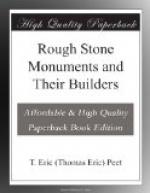It is thus clear that the nuraghi were the fortified centres of the various villages of Sardinia. Probably each formed the residence of the local chieftain; that they were actually inhabited is clear from the remains of everyday life found in them, and from the polish which continual use has set on the side-walls of some of the staircases. In general appearance and design the nuraghi recall the modern truddhi, hundreds of which dot the surface of Apulia and help to beguile the tedium of the railway journey from Brindisi to Foggia. The truddhi, however, are built in steps or terraces and have no upper chamber.
Who were the foes against whom such elaborate preparations for defence were made? Two alternatives are possible. Either Sardinia was a continual prey to some piratical Mediterranean people, or she was divided against herself through the rivalry of the local chieftains.
The second explanation is perhaps the more probable. Mackenzie seems to adopt it, and fancies that in the growth of the largest nuraghi we may trace the rise to power of some of these local dynasts at the expense of their neighbours. He suggests that the existence of the fortified enclosure of Nossiu, where there is no sign of a true nuraghe, may mean that there were certain communities which succeeded in maintaining their independence in the face of these powerful rulers. But here, as he himself is the first to admit, we are in the realm of pure conjecture.
[Illustration: Fig. 18. Giant’s Tomb at Muraguada, Sardinia. (Mackenzie, Papers of the British School of Rome, V.)]
It is now established that in the Giants’ Tombs of Sardinia we are to see the graves of the inhabitants of the nuraghe villages. Every Giant’s Tomb lies close to such a village, and almost every village has its Giants’ Tombs, one or more in number according to its size. A Giant’s Tomb consists of a long rectangular chamber of upright slabs roofed by corbelled masonry (Fig. 18). The slab which closes one end of the tomb is of great size, and consists of a lower rectangular half with a small hole at the base and an upper part shaped like a rounded gable. There is a raised border to the whole slab, and a similar band in relief marks out the two halves. This front slab forms the centre-piece in a curved facade of upright slabs. The chamber is covered with a coating of ashlar masonry, which is shaped into an apsidal form at the end opposite to the facade. Occasionally more than 50 feet in length, the Giants’ Tombs served as graves for whole families, or even for whole villages. Mackenzie has shown that the form is derived from the simple dolmen, and has pointed out several of the intermediate stages.
The inhabitants of Sardinia in the megalithic period also buried their dead in rock-hewn sepulchres, of which there are numerous examples at Anghelu Ruju. The contents of these graves make it clear that they are the work of the same people as the Giants’ Graves. Were further proof needed it could be afforded by a grave at Molafa, where a Giant’s Grave with its facade and gabled slab has been faithfully imitated in the solid rock. There is a similar tomb at St. George. Two natural caves in Cape Sant’ Elia on the south of the island contain burials of this same period.




